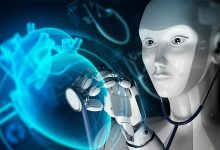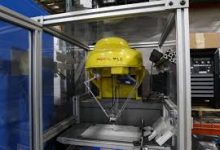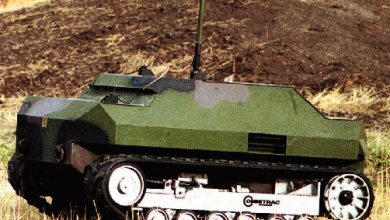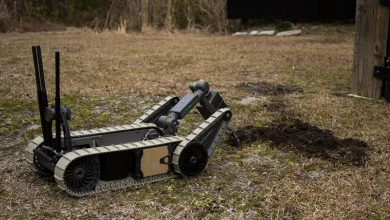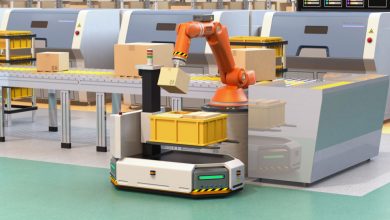Industrial Robotics: An Overview
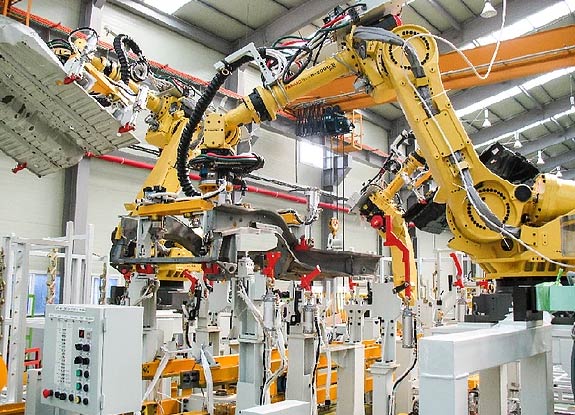
Industrial Robotics:
Driving Efficiency and Innovation in Manufacturing
Industrial robotics represents a cornerstone of modern manufacturing, revolutionizing production processes, enhancing efficiency, and driving innovation across industries. These sophisticated machines, equipped with precision actuators, advanced sensors, and intelligent control systems, perform a wide range of tasks with speed, accuracy, and reliability. This comprehensive exploration delves into the realm of industrial robotics, unraveling its evolution, applications, challenges, and transformative impact on the manufacturing landscape.
- Evolution of Industrial Robotics:
The roots of industrial robotics can be traced back to the mid-20th century when the first programmable robotic arm, the Unimate, was introduced by George Devol and Joseph Engelberger in the early 1960s. Initially used for tasks such as welding and material handling in automotive factories, industrial robots quickly gained traction in various manufacturing sectors due to their ability to automate repetitive and labor-intensive tasks. Over the decades, advancements in electronics, computing, and materials have led to the development of more versatile, agile, and intelligent industrial robots capable of performing complex assembly, machining, and inspection tasks with precision and efficiency.
Types of Industrial Robotics:
- Pioneering Beginnings:
The genesis of industrial robotics can be traced back to the early 1960s when the Unimate, the world’s first programmable robotic arm, was introduced by engineers George Devol and Joseph Engelberger. Developed for General Motors’ assembly line tasks, the Unimate revolutionized manufacturing by automating repetitive and hazardous tasks such as welding and material handling. This groundbreaking innovation laid the foundation for the widespread adoption of industrial robots across various industries, heralding the dawn of the automation era.
- Advancements in Control and Programming:
Throughout the 1970s and 1980s, industrial robotics witnessed significant advancements in control systems and programming techniques, enabling robots to perform increasingly complex tasks with precision and efficiency. The introduction of computer numerical control (CNC) technology allowed for precise motion control and trajectory planning, improving the accuracy and repeatability of robotic movements. Furthermore, the development of programming languages such as APT (Automatically Programmed Tool) and VAL (Robotics Control Language) simplified the programming of robots, making them more accessible to users with varying levels of technical expertise.
- Expansion of Applications:
The 1990s marked a period of diversification and expansion in the applications of industrial robotics, as robots were deployed in a wide range of industries beyond automotive manufacturing. In electronics manufacturing, robots were used for tasks such as soldering, pick-and-place assembly, and inspection, enabling the production of electronic components and devices with high precision and reliability. In pharmaceutical manufacturing, robots facilitated tasks such as dispensing, packaging, and labeling of pharmaceutical products, improving efficiency and compliance with regulatory standards. Additionally, robots found applications in industries such as aerospace, consumer goods, food and beverage, and logistics, driving advancements in automation and efficiency across diverse sectors.
- Integration of Vision and Sensing Technologies:
The early 21st century witnessed the integration of vision and sensing technologies into industrial robotics, enabling robots to perceive and interact with their environment with greater intelligence and autonomy. Vision systems, consisting of cameras, image processing algorithms, and machine vision software, allowed robots to detect and identify objects, navigate complex environments, and perform tasks with visual feedback. Sensing technologies such as force/torque sensors and proximity sensors enabled robots to sense and respond to external forces, ensuring safe and accurate operation in dynamic and unstructured environments.
- Rise of Collaborative Automation:
In recent years, the rise of collaborative automation has emerged as a transformative trend in industrial robotics, blurring the boundaries between humans and machines and enabling new forms of human-robot interaction in the manufacturing workplace. Collaborative robots, or cobots, are designed to work alongside humans in shared workspaces, performing tasks that require close collaboration and interaction. Unlike traditional industrial robots, which are typically confined to safety cages and isolated from human workers, cobots are equipped with advanced sensors and safety features that enable safe and intuitive interaction with human operators. Collaborative robots find applications in tasks such as assembly, inspection, packaging, and material handling, enhancing productivity, flexibility, and ergonomics in manufacturing operations.
- Future Directions and Opportunities:
Looking ahead, the future of industrial robotics holds boundless opportunities for further innovation and advancement, driven by emerging technologies such as artificial intelligence (AI), machine learning, and Internet of Things (IoT) connectivity. AI algorithms enable robots to learn from data, adapt to changing conditions, and optimize performance, leading to more intelligent and autonomous robotic systems. Machine learning techniques allow robots to improve their capabilities over time through experience and feedback, enabling continuous optimization and refinement of tasks. IoT connectivity enables robots to communicate and share data with other machines and systems in the manufacturing ecosystem, enabling real-time monitoring, analysis, and optimization of production processes.
- Conclusion:
In conclusion, the evolution of industrial robotics represents a journey of innovation, progress, and transformation in the manufacturing landscape. From the pioneering beginnings of the Unimate to the rise of collaborative automation, industrial robotics has undergone significant advancements, reshaping production processes, enhancing productivity, and revolutionizing industries. As technology continues to advance and evolve, the integration of industrial robotics with emerging technologies such as AI, machine learning, and IoT offers new opportunities for manufacturers to enhance agility, flexibility, and competitiveness in the global marketplace. By embracing the transformative power of industrial robotics, manufacturers can unlock new levels of productivity, quality, and efficiency, driving innovation and prosperity in the 21st century and beyond.
- Applications in Manufacturing:
Industrial robots find applications in a wide range of manufacturing processes, spanning industries such as automotive, electronics, aerospace, pharmaceuticals, and consumer goods. In automotive manufacturing, robots are used for tasks such as welding, painting, assembly, and material handling, enabling mass production of vehicles with consistent quality and precision. In electronics manufacturing, robots perform tasks such as soldering, pick-and-place assembly, and inspection, facilitating the production of electronic components and devices with high accuracy and reliability. In aerospace manufacturing, robots are used for machining, drilling, and assembly of aircraft components, improving productivity and reducing lead times.
- Early Days of Automation:
The history of robotics applications in manufacturing can be traced back to the early 20th century with the advent of assembly lines and mass production techniques. Early forms of automation, such as conveyor belts and mechanized assembly stations, were introduced to streamline production processes and increase efficiency in industries such as automotive, electronics, and consumer goods. However, these early automation systems lacked the flexibility and adaptability required to respond to changing market demands and product variations.
- Introduction of Industrial Robots:
The introduction of industrial robots in the 1960s marked a significant milestone in the evolution of robotics applications in manufacturing. The Unimate, developed by engineers George Devol and Joseph Engelberger, became the world’s first programmable robotic arm deployed on General Motors’ assembly lines for tasks such as welding and material handling. Industrial robots revolutionized manufacturing by automating repetitive and labor-intensive tasks, improving productivity, and ensuring consistent quality in production processes. Over the decades, advancements in robotics technology led to the development of more versatile, agile, and intelligent industrial robots capable of performing complex assembly, machining, and inspection tasks with precision and efficiency.
- Diversification of Applications:
The 1980s and 1990s witnessed a diversification of robotics applications in manufacturing, as robots found use in a wide range of industries beyond automotive manufacturing. In electronics manufacturing, robots were deployed for tasks such as soldering, pick-and-place assembly, and inspection, enabling the production of electronic components and devices with high precision and reliability. In aerospace manufacturing, robots were used for machining, drilling, and assembly of aircraft components, improving productivity and reducing lead times. Additionally, robots found applications in industries such as pharmaceuticals, food and beverage, consumer goods, and logistics, driving advancements in automation and efficiency across diverse sectors.
- Integration of Vision and Sensing Technologies:
In the early 21st century, the integration of vision and sensing technologies into robotics applications revolutionized manufacturing by enabling robots to perceive and interact with their environment with greater intelligence and autonomy. Vision systems, consisting of cameras, image processing algorithms, and machine vision software, allowed robots to detect and identify objects, navigate complex environments, and perform tasks with visual feedback. Sensing technologies such as force/torque sensors and proximity sensors enabled robots to sense and respond to external forces, ensuring safe and accurate operation in dynamic and unstructured environments.
- Emergence of Collaborative Automation:
In recent years, the emergence of collaborative automation has emerged as a transformative trend in robotics applications in manufacturing, enabling new forms of human-robot interaction and cooperation in the manufacturing workplace. Collaborative robots, or cobots, are designed to work alongside humans in shared workspaces, performing tasks that require close collaboration and interaction. Unlike traditional industrial robots, which are typically confined to safety cages and isolated from human workers, cobots are equipped with advanced sensors and safety features that enable safe and intuitive interaction with human operators. Collaborative robots find applications in tasks such as assembly, inspection, packaging, and material handling, enhancing productivity, flexibility, and ergonomics in manufacturing operations.
- Transition to Smart Factories:
As we look to the future, the evolution of robotics applications in manufacturing is leading toward the transition to smart factories, characterized by interconnected systems, data-driven decision-making, and autonomous production processes. Smart factories leverage technologies such as artificial intelligence (AI), machine learning, and Internet of Things (IoT) connectivity to optimize efficiency, quality, and flexibility in manufacturing operations. AI algorithms enable robots to learn from data, adapt to changing conditions, and optimize performance, leading to more intelligent and autonomous robotic systems. Machine learning techniques allow robots to improve their capabilities over time through experience and feedback, enabling continuous optimization and refinement of tasks. IoT connectivity enables robots to communicate and share data with other machines and systems in the manufacturing ecosystem, enabling real-time monitoring, analysis, and optimization of production processes.
- Conclusion:
In conclusion, the evolution of robotics applications in manufacturing represents a transformative journey that has reshaped production processes, optimized efficiency, and driven innovation in industries worldwide. From the early days of automation on assembly lines to the emergence of smart factories powered by advanced robotics and artificial intelligence, robotics applications have revolutionized manufacturing and propelled industries into the digital age. As technology continues to advance and evolve, the integration of robotics applications with emerging technologies such as AI, machine learning, and IoT offers new opportunities for manufacturers to enhance agility, flexibility, and competitiveness in the global marketplace. By embracing the transformative power of robotics applications, manufacturers can unlock new levels of productivity, quality, and efficiency, driving innovation and prosperity in the 21st century and beyond.
- Key Technologies and Components:
Industrial robots comprise several key technologies and components that enable their operation and functionality. Actuators, such as electric motors and pneumatic cylinders, provide motion
and force to manipulate objects and perform tasks. Sensors, including cameras, proximity sensors, and force/torque sensors, enable robots to perceive their environment, detect objects, and ensure safe and accurate operation. Controllers, consisting of microprocessors and software algorithms, coordinate the motion of actuators, process sensor data, and execute tasks according to predefined instructions. End effectors, such as grippers, welding torches, and suction cups, enable robots to interact with workpieces and perform specific tasks based on the application requirements.
- Actuators:
Actuators serve as the muscle of a robot, converting energy into mechanical motion to drive movement and perform tasks. They come in various forms, including electric motors, hydraulic actuators, and pneumatic systems. Electric motors, such as DC motors and stepper motors, are commonly used for their precise control and versatility in robotic applications. Hydraulic actuators utilize pressurized fluids to generate powerful and controlled motion, making them suitable for heavy-duty tasks in industrial environments. Pneumatic systems, powered by compressed air, offer rapid and responsive motion, ideal for applications requiring speed and agility.
- Sensors:
Sensors serve as the sensory organs of a robot, providing information about the surrounding environment and enabling perception and interaction. A diverse array of sensors is used in robotics, including cameras, LIDAR (Light Detection and Ranging), ultrasonic sensors, and proximity sensors. Cameras capture visual information, allowing robots to recognize objects, navigate environments, and perform tasks requiring visual feedback. LIDAR sensors emit laser beams to generate detailed 3D maps of the surroundings, facilitating autonomous navigation and obstacle avoidance. Ultrasonic sensors detect distance and proximity to objects, while proximity sensors detect the presence of objects within a defined range, enhancing safety and control in robotic systems.
- Controllers:
Controllers serve as the brain of a robot, responsible for processing sensory inputs, executing algorithms, and generating commands for actuators. Microcontrollers and microprocessors are commonly used in robotics to control motor movements, implement feedback loops, and coordinate multiple sensors and actuators. These controllers run sophisticated algorithms, such as motion planning, pathfinding, and machine learning, enabling robots to make intelligent decisions and adapt to changing conditions in real-time. Advanced control techniques, such as proportional-integral-derivative (PID) control and model predictive control, are employed to achieve precise and stable motion control in robotic systems.
- Power Supply:
A reliable power supply is essential for the operation of a robot, providing energy to drive actuators, power sensors, and run control electronics. Robots may be powered by batteries, internal combustion engines, or external power sources, depending on their application and mobility requirements. Battery-powered robots offer portability and flexibility, making them suitable for applications such as mobile robotics and consumer electronics. Internal combustion engines are used in larger robots, such as industrial vehicles and drones, where extended runtime and high power output are required. External power sources, such as electric outlets or power cables, may be used for stationary robots in industrial settings.
- End Effectors:
End effectors are the tools or attachments mounted at the end of a robot’s arm or manipulator, enabling it to interact with the environment and perform specific tasks. Grippers, suction cups, and electromagnets are common types of end effectors used for grasping and manipulating objects. Welding torches, cutting tools, and 3D printers are specialized end effectors used in industrial applications such as welding, machining, and additive manufacturing. End effectors may be designed for a specific task or interchangeable to accommodate different applications, allowing robots to adapt to diverse environments and tasks efficiently.
- Artificial Intelligence and Software:
Artificial intelligence (AI) and software play an increasingly important role in robotics, enabling robots to perceive, reason, and act in complex and dynamic environments. AI algorithms, including machine learning, computer vision, and natural language processing, enable robots to learn from data, recognize patterns, and make decisions autonomously. Computer vision algorithms analyze visual data from cameras to detect objects, recognize gestures, and navigate environments. Machine learning algorithms enable robots to improve their performance over time through experience and feedback, enabling continuous optimization and refinement of tasks.
- Conclusion:
In conclusion, the key technologies and components of robotics form the foundation of robotic systems, enabling them to perceive, process, and interact with the world around them. Actuators provide motion, sensors gather information, controllers process data, power supplies energize the system, and end effectors perform tasks. Additionally, artificial intelligence and software enable robots to perceive, reason, and act in complex environments, unlocking new capabilities and functionalities. As robotics technology continues to advance and evolve, innovations in key technologies and components will drive the development of more capable, versatile, and intelligent robots, further expanding the possibilities of automation and robotics in various industries and sectors.
- Advantages of Industrial Robotics:
Industrial robotics offers numerous advantages to manufacturers, including increased productivity, improved quality, enhanced flexibility, and reduced costs. By automating repetitive and manual tasks, robots can operate continuously and consistently without fatigue or errors, leading to higher throughput and efficiency in production processes. Robots can also perform tasks with high precision and repeatability, resulting in improved product quality and reduced rework or scrap rates. Furthermore, industrial robots can be reprogrammed and reconfigured to adapt to changing production requirements, offering flexibility and scalability in manufacturing operations. Additionally, robots can perform tasks in hazardous or inaccessible environments, protecting human workers from potential harm and improving workplace safety.
- Challenges and Considerations:
Despite the numerous benefits of industrial robotics, the adoption and integration of robotic systems pose several challenges and considerations for manufacturers. Initial investment costs for purchasing and installing robotic systems can be significant, requiring careful financial planning and justification to ensure a return on investment. Additionally, programming and configuring robots to perform specific tasks may require specialized expertise and training, necessitating the recruitment or training of skilled personnel. Furthermore, ensuring compatibility and integration with existing manufacturing equipment and processes can be complex and time-consuming, requiring careful coordination and collaboration between various stakeholders. Finally, concerns about job displacement and workforce implications may arise as automation replaces human labor in certain tasks, necessitating strategies for workforce reskilling, retraining, and redeployment.
- Future Trends and Outlook:
Looking ahead, the future of industrial robotics holds promise for further advancements and innovations that will shape the manufacturing landscape. Emerging technologies such as collaborative robots (cobots), artificial intelligence (AI), and Internet of Things (IoT) connectivity are expected to drive new capabilities and functionalities in industrial robots. Cobots, designed to work alongside humans in shared workspaces, offer opportunities for enhanced human-robot collaboration and flexibility in manufacturing operations. AI algorithms enable robots to learn from data, adapt to dynamic environments, and optimize performance, leading to more intelligent and autonomous robotic systems. IoT connectivity allows robots to communicate and share data with other machines and systems in the manufacturing ecosystem, enabling real-time monitoring, analysis, and optimization of production processes.
- Conclusion:
In conclusion, industrial robotics represents a cornerstone of modern manufacturing, enabling companies to achieve higher levels of productivity, quality, and efficiency in production processes. From automotive assembly lines to electronics manufacturing facilities, industrial robots play a vital role in driving innovation and competitiveness across industries. As technology continues to advance and evolve, the integration of industrial robotics with emerging technologies such as AI, IoT, and cobots offers new opportunities for manufacturers to enhance agility, flexibility, and responsiveness in the face of changing market demands and business requirements. By embracing the transformative power of industrial robotics, manufacturers can unlock new levels of productivity, quality, and competitiveness in the global marketplace.
